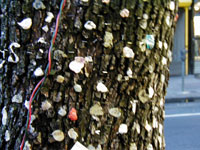Dear Umbra,
I shudder at the triviality of the question, but so far nobody I’ve asked has been able to provide a satisfying answer. So here it is: Is chewing gum biodegradable? Can I spit it on the compost instead of sticking it under the chair? Would green stalks sprout from the gum-spot-riddled sidewalks if we didn’t trod them down?
I hope you can finally reveal the secret of what is the core of the matter, besides spearmint and sweetener.
Birgit
Frankfurt, Germany
Dearest Birgit,
Shudder only in repulsion. I can indeed reveal the secret: The answers to your questions are no, no, and no. You touch upon the gum-spotted sidewalks, a scourge to city managers ’round the world. (Except in Singapore, where it’s against the law to chew gum unless you have a medical exemption.) Why doth the gum blot the sidewalk and stay on the school desk for all eternity? Because, alas, it is made in part from not only non-nutritive but also non-biodegradable substances.

Stuck on you: a gum-covered tree.
Every commercial gum has a gum base, just like every trophy has a trophy base, and in some cases the two are disturbingly similar. The base makes up a percentage of the gum; the remaining ingredients are flavor and sugar. Gum bases are the part that we chew and chew and chew long after the flavor is just a memory. They are grouped in categories: elastomers (including natural and synthetic rubbers), resins, plasticizers (such as waxes, vegetable oils, and glycerides), adjuvants (including calcium carbonate, talc, or other charging agents), and antioxidants. In other words, the gum is, at base, plastic or rubber or wax.
The bottom line: Don’t spit your gum out in the compost or on the sidewalk, and don’t stick it under the table; put it in the trash. Contrary to persistent urban legends, you can also swallow your gum. It’ll eventually pass right on through, undigested. Yum.
Stickily,
Umbra

